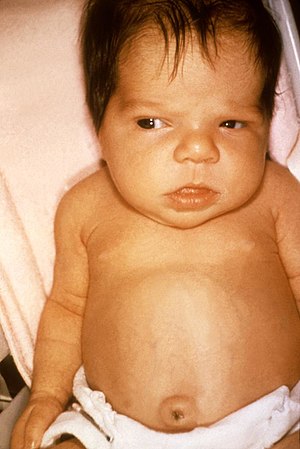Congenital hypothyroidism
| Congenital hypothyroidism | |
|---|---|
 |
|
| 6 week old female with symptoms of jaundice due to hypothyrodism. This patient was treated with supplemental thyroid hormonal therapy, and appeared to be a normal healthy child at 1 year of age. | |
| Classification and external resources | |
| Specialty | endocrinology |
| ICD-10 | E00, E03.0, E03.1 |
| ICD-9-CM | 243 |
| DiseasesDB | 6612 |
| MedlinePlus | 001193 |
| MeSH | D003409 |
Congenital hypothyroidism (CH) is a condition of thyroid hormone deficiency present at birth. Approximately 1 in 4000 newborn infants has a severe deficiency of thyroid function, while even more have mild or partial degrees. If untreated for several months after birth, severe congenital hypothyroidism can lead to growth failure and permanent intellectual disability. Treatment consists of a daily dose of thyroid hormone (thyroxine) by mouth. Because the treatment is simple, effective, and inexpensive, nearly all of the developed world practices newborn screening to detect and treat congenital hypothyroidism in the first weeks of life.
Infants born with congenital hypothyroidism may show no effects, or may display mild effects that often go unrecognized as a problem: excessive sleeping, reduced interest in nursing, poor muscle tone, low or hoarse cry, infrequent bowel movements, exaggerated jaundice, and low body temperature. If fetal deficiency was severe because of complete absence (athyreosis) of the gland, physical features may include a larger anterior fontanel, persistence of a posterior fontanel, an umbilical hernia, and a large tongue (macroglossia).
In the era before newborn screening, less than half of cases of severe hypothyroidism were recognized in the first month of life. As the months proceeded, these infants would grow poorly and be delayed in their development. By several years of age, they would display the recognizable facial and body features of cretinism. Persistence of severe, untreated hypothyroidism resulted in severe mental impairment, with an IQ below 80 in the majority. Most of these children eventually ended up in institutional care.
...
Wikipedia
